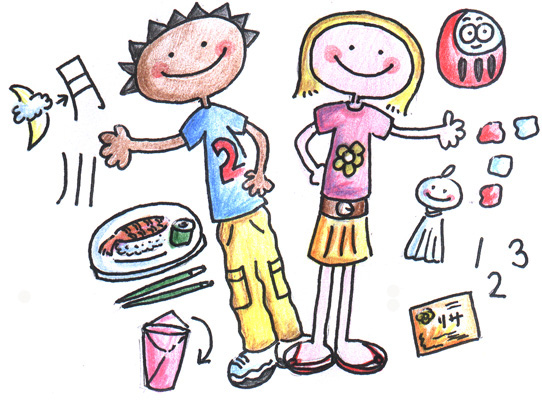Lesson 1
Lesson Plan Download pdf
Main (20 minutes)
Using flash cards, the greetings presentation or other props to help, give the following greetings:
| ohayo gozaimasu | おはようございます | good morning |
| konnichiwa | こんにちは | hello |
| sayonara | さようなら | goodbye |
Hold up a greetings flashcard / wear prop – are children able to give the accurate greeting in response to the stimulus?
‘gozaimasu’ is a polite suffix which when added to certain words shows respect to the person you are talking to. Ohayo, for example, can be said on its own to mean ‘good morning’ and is commonly said amongst friends and close family members. When gozaimasu is added, the phrase automatically becomes more polite and would be used by pupils when talking to their teacher for instance.
With the Japanese teacher, present the following conversation. Alternatively, use the example dialogue soundfiles:
| A: o-namae wa? | what’s your name? |
| おなまえは | |
| B: watashi/ boku wa …desu | I am… |
| わたしは…です。 | ぼくは…です。 |
| eg. watashi wa ikumi desu | I'm Ikumi (girl) | わたしはいくみです。 |
| bokui wa tsuyoshi desu | I'm Tsuyoshi (boy) | ぼくはつよしです。 |
‘boku’ is used by males only – watashi can be used by both sexes and means ‘I’
A is/am/are B. = A wa B desu.
‘desu’ has no real translation in English - it is simply a polite marker added onto the end of some sentences. Although spelt ‘desu’, the final ‘u’ is not generally pronounced, so it sounds like ‘des’.
‘o-namae wa?’ with rising intonation is an abbreviation of the question ‘o-namae wa nan desu
ka’.
‘ka - か’is the marker which shows a question has been asked.
Extension
Children work in pairs and practise the conversation, adding hello and goodbye where
appropriate!
Ask for pairs of volunteers to demonstrate their conversations. Correct pronunciation where necessary, using the dialogue soundfiles to help.
